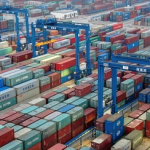Russia is important for India as a major source of energy, raw materials, and military hardware. The provision of all of these has become increasingly complicated due to ever tightening sanctions on Russia since 2008. While India doesn’t recognise unilateral sanctions, the role of the U.S. in the international financial architecture means that most privately owned Indian corporations prefer not to do business with Russia. As India’s economy is largely driven by the private sector, this reduces opportunities for economic engagement with Russia. India’s dealings with Russia in the defence and energy space are largely carried out by government-owned companies.
One of the ways proposed to enable India-Russia economic ties has been to use the Indian rupee and the Russian ruble to pay for imports/exports rather than relying on the dollar as a means of exchange. It will be difficult to make this work, due to the imbalance in bilateral trade. Despite the Western sanctions on Russia, India-Russia trade shot up during 2022. India’s imports from Russia totalled $32.8 billion from April-December 2022 – three times the corresponding figure for the previous year. This increase is due to higher imports of petroleum, because of the reshuffle in global energy markets. At the same time, India’s exports to Russia fell by over one-third, amounting to a mere $2.2 billion for the same period. With such an imbalance in trade, the bilateral use of national currencies cannot work.
Multiple countries have been affected by Western sanctions in the past and are trying to find ways to work around the dollar’s dominance. There is the example of Russia and China, which are using the Chinese Yuan for bilateral trade. Likewise, there was a report in 2022 that Saudi Arabia may accept payments for its oil in Chinese Yuan. India too, is exploring the expanded use of the rupee as an international currency. In January 2023, Brazil and Argentina also said that they were exploring an arrangement so that bilateral trade could be conducted in a common currency other than the US dollar. While there may be multiple motivations for these, the unease at the role the US dollar plays in international commerce, and how it is used to conduct war by other means has played a role. Central banks around the world have also raised their gold holdings during 2023; unlike the dollar reserves, these cannot be locked out. Several economies are trying to find ways around America’s financial hegemony.
However, none of the currencies mentioned earlier are likely to replace the dollar in the foreseeable future. Fiat currency, first and foremost, is about trust. In case of China, trust is a major issue. If Jack Ma’s assets can be seized by the state, then whose assets are safe? The risk is greater than dollar risk. In the case of Latin America, stability and trust are both factors to consider. Argentina currently has over a dozen exchange rates and inflation of over 50%. Between them, Brazil and Argentina have introduced a new currency eight or nine times since the 1980s. Unlike the dollar, a currency which is dictated by the two governments will have little credibility. In India’s case, the Reserve Bank is very sensitive about having the Indian rupee held overseas. Additionally, the Indian rupee is not freely convertible. However, it will play a larger global role in the coming years. This is not very well known, but the Indian rupee used to be the currency for most of the Indian Ocean rim countries a hundred years ago. As late as 1969, the United Arab Emirates and some of the other Gulf States used the Indian rupee as their currency. The role of the Indian rupee in international trade eroded as the Indian economy went into relative decline in the 1960s and 1970s. As India’s economy grows, the rupee will regain some of its lost role. To some extent, the Indian rupee is a hard currency in South Asia, for countries such as Sri Lanka, Nepal and Bangladesh. As the Indian economy regains its lost stature, a larger role for the Indian rupee in the Indian Ocean region is feasible.
As other currencies play a larger role, the role of the dollar will automatically ebb, somewhat mitigating the impact of sanctions. These measures are going to be piecemeal and will have a limited impact for several years. However, sanctions on Russia are going to stay for a long time – and planners need to think 10-15 years ahead.
Russia imports very little from India, and this is unlikely to change. Given its population and demographics, Russia will be a relatively small market. Other ways are needed to redress the balance. One way to address this imbalance is via movement of labour. The West Asian model can be instructive. India imports over 1.5 billion barrels of oil, much of it from West Asia. Simultaneously, over 8 million Indians work in West Asia, and account for a large chunk of the $90 billion that India gets via foreign remittances. The two flows partly cancel each other out. Apart from the flow of goods and funds, there is also the issue of demographics. In case of the West Asian states, they allow residency without citizenship – addressing the fears of a demographic shift.
Russia needs to explore this avenue more seriously – a similar arrangement, allowing Indian workers to work in the natural resource and service sectors, with residency rights but with some constraints on acquiring citizenship. Worker remittances can help offset the trade imbalance between the two countries. These remittances can also provide the volume needed to create financial infrastructure between the two countries. Such flows will also create a space for small and medium enterprises operating between the two countries. Unlike large corporations, these enterprises are small enough to fly under the radar and harder for Western sanctions to target.
Amit Bhandari is Senior Fellow for Energy, Investment and Connectivity, Gateway House.
This article was published by the Valdai Discussion Club.


